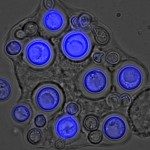Link to Pubmed [PMID] – 32487759
Link to DOI – e01060-2010.1128/mBio.01060-20
mBio 2020 06; 11(3):
Many species of pathogenic fungi deploy the unfolded protein response (UPR) to expand the folding capacity of the endoplasmic reticulum (ER) in proportion to the demand for virulence-related proteins that traffic through the secretory pathway. Although Ca2+ plays a pivotal role in ER function, the mechanism by which transcriptional upregulation of the protein folding machinery is coordinated with Ca2+ homeostasis is incompletely understood. In this study, we investigated the link between the UPR and genes encoding P-type Ca2+-ATPases in the human-pathogenic mold Aspergillus fumigatus We demonstrate that acute ER stress increases transcription of the srcA gene, encoding a member of the sarco/endoplasmic reticulum Ca2+-ATPase (SERCA) family, as well as that of pmrA, encoding a secretory pathway Ca2+-ATPase (SPCA) in the Golgi membrane. Loss of the UPR transcription factor HacA prevented the induction of srcA and pmrA transcription during ER stress, defining these ER/Golgi Ca2+ pumps as novel downstream targets of this pathway. While deletion of srcA alone caused no major deficiencies, a ΔsrcA/ΔpmrA mutant displayed a severe polarity defect, was hypersensitive to ER stress, and showed attenuated virulence. In addition, cell wall analyses revealed a striking reduction in mannose levels in the absence of both Ca2+ pumps. The ΔhacA mutant was hypersensitive to agents that block calcineurin-dependent signaling, consistent with a functional coupling between the UPR and Ca2+ homeostasis. Together, these findings demonstrate that the UPR integrates the need for increased levels of chaperone and folding enzymes with an influx of Ca2+ into the secretory pathway to support fungal growth, stress adaptation, and pathogenicity.IMPORTANCE The UPR is an intracellular signal transduction pathway that maintains homeostasis of the ER. The pathway is also tightly linked to the expression of virulence-related traits in diverse species of human-pathogenic and plant-pathogenic fungal species, including the predominant mold pathogen infecting humans, Aspergillus fumigatus Despite advances in the understanding of UPR signaling, the linkages and networks that are governed by this pathway are not well defined. In this study, we revealed that the UPR is a major driving force for stimulating Ca2+ influx at the ER and Golgi membranes and that the coupling between the UPR and Ca2+ import is important for virulence, cell wall biosynthesis, and resistance to antifungal compounds that inhibit Ca2+ signaling.


